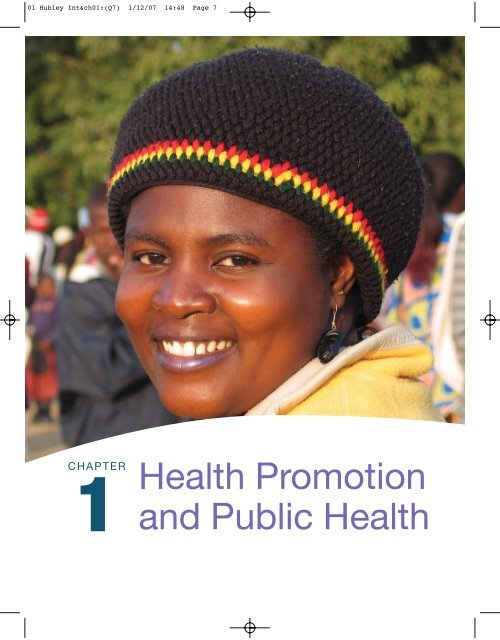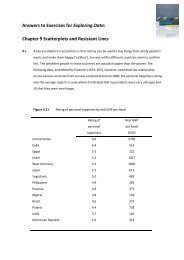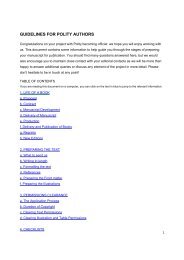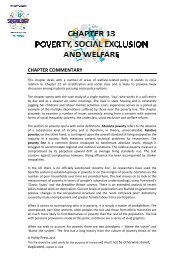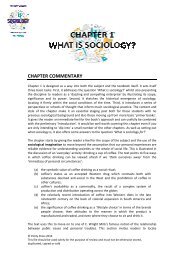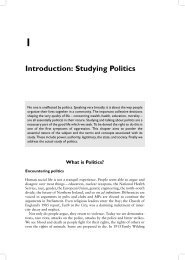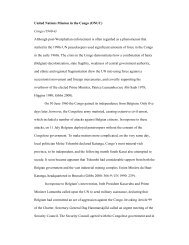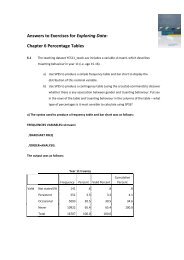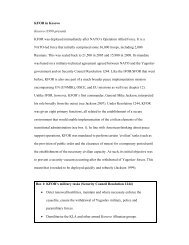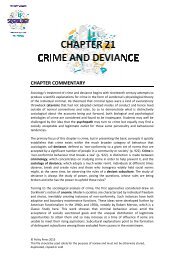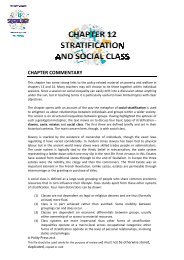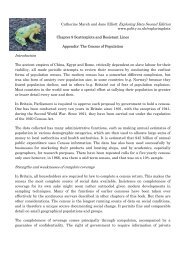You also want an ePaper? Increase the reach of your titles
YUMPU automatically turns print PDFs into web optimized ePapers that Google loves.
<strong>01</strong> <strong>Hubley</strong> Int&ch<strong>01</strong>:(<strong>Q7</strong>) 1/12/07 14:48 Page 7<br />
CHAPTER<br />
1<br />
Health Promotion<br />
and Public Health
<strong>01</strong> <strong>Hubley</strong> Int&ch<strong>01</strong>:(<strong>Q7</strong>) 1/12/07 14:48 Page 8<br />
Contents<br />
What is health promotion?<br />
Putting health promotion into practice –<br />
regrouping the five dimensions of the<br />
10<br />
Ottawa Charter<br />
Health promotion as a multi-disciplinary<br />
11<br />
activity 14<br />
The scope for prevention of ill health and<br />
rationale for the promotion of health 15<br />
Historical overview of health promotion<br />
Criticisms of health education and the<br />
16<br />
emergence of health promotion 17<br />
Inequalities in health 19<br />
The New Public Health 21<br />
Debates in Health Promotion<br />
The relevance of medical and social models of<br />
22<br />
health and disease 23<br />
Individual and structural approaches 24<br />
Levels of health-promotion practice 24<br />
Core values of health promotion<br />
Coercion, persuasion or health-empowerment<br />
26<br />
approaches 29<br />
8<br />
Ethics of health promotion 29<br />
Principles of health-promotion practice 30<br />
Health-promotion planning process 31<br />
Needs/situation analysis 31<br />
Health needs 32<br />
Influences on health 32<br />
Influences on health actions 32<br />
Target groups 33<br />
Defining the health-promotion strategy 33<br />
Approach 34<br />
Methods 34<br />
Settings<br />
Implementation/evaluation, reflection and<br />
34<br />
learning<br />
Some concluding remarks on health<br />
35<br />
promotion 35<br />
Further reading 36
<strong>01</strong> <strong>Hubley</strong> Int&ch<strong>01</strong>:(<strong>Q7</strong>) 1/12/07 14:48 Page 9<br />
CHAPTER<br />
1<br />
Health Promotion<br />
and Public Health<br />
Key issues within this chapter:<br />
● Health promotion is a key element of public health practice.<br />
● Health promotion involves a combination of health education, service<br />
improvement and advocacy.<br />
● Many health workers, professional groups, community-based workers and<br />
volunteers have a role in health promotion.<br />
● Health promotion is an evolving discipline with many ongoing debates<br />
concerning principles and practice, including the balance between health<br />
education and legislation, the role of individualistic and structuralist<br />
approaches, the levels at which to operate, the nature of the core<br />
values/ethical principles and the balance between coercive, persuasive and<br />
health empowerment approaches.<br />
● A systematic approach to planning health promotion needs to take into<br />
account assessment of needs and influences on health and involves<br />
decisions on target groups, methods, settings and timing of activities.<br />
By the end of this chapter you should be able to:<br />
● understand the history of prevention, public health and the evolution of<br />
health promotion<br />
● define health promotion and its component parts – health education, service<br />
improvement and advocacy<br />
● have considered the debates in health promotion including approaches and<br />
core values/ethical principles, and assessed your own personal approach.<br />
● apply principles of health promotion to planning a health-promotion<br />
intervention.<br />
9
<strong>01</strong> <strong>Hubley</strong> Int&ch<strong>01</strong>:(<strong>Q7</strong>) 1/12/07 14:48 Page 10<br />
10 Health-Promotion Needs Assessment<br />
What is Health Promotion?<br />
The starting point for any discussion of health promotion is the Ottawa Charter,<br />
which in 1986 set out the concept of health promotion (WHO, 1986). Alongside the<br />
five key areas of action, summarized in box 1.1, the Ottawa Charter also reaffirmed the<br />
importance of community participation and introduced the goal of empowerment –<br />
a concept of which we will say more later in this book.<br />
Box 1.1 Extracts from the Ottawa Charter for Health Promotion<br />
Health promotion is the process of enabling<br />
people to increase control over, and to<br />
improve, their health. To reach a state of<br />
complete physical, mental and social<br />
well-being, an individual or group must be<br />
able to identify and to realize aspirations,<br />
to satisfy needs, and to change or cope<br />
with the environment. Health is, therefore,<br />
seen as a resource for everyday life, not<br />
the objective of living. Health is a positive<br />
concept emphasizing social and personal<br />
resources, as well as physical capacities.<br />
Therefore, health promotion is not just<br />
the responsibility of the health sector,<br />
but goes beyond healthy life-styles to<br />
well-being.<br />
HEALTH PROMOTION ACTION MEANS:<br />
Building Healthy Public Policy – Health<br />
promotion goes beyond health care. It puts<br />
health on the agenda of policy makers in<br />
all sectors and at all levels. It directs policy<br />
makers to be aware of the health<br />
consequences of their decisions and<br />
accept their responsibilities for health.<br />
Health promotion policy combines<br />
diverse but complementary approaches<br />
including legislation, fiscal measures,<br />
taxation and organizational change. It is<br />
coordinated action that leads to health,<br />
income and social policies that foster<br />
greater equity. Joint action contributes to<br />
ensuring safer and healthier goods and<br />
services, healthier public services, and<br />
cleaner, more enjoyable environments.<br />
Health promotion policy requires the<br />
identification of obstacles to the adoption<br />
of healthy public policies in non-health<br />
sectors, and ways of removing them. The<br />
aim must be to make the healthier choice<br />
the easier choice.<br />
Creating Supportive Environments –<br />
Health promotion generates living and<br />
working conditions that are safe,<br />
stimulating, satisfying and enjoyable.<br />
Systematic assessment of the health<br />
impact of a rapidly changing environment<br />
– particularly in areas of technology, work,<br />
energy production and urbanization – is<br />
essential and must be followed by action to<br />
ensure positive benefit to the health of the<br />
public. The protection of the natural and<br />
built environments and the conservation of<br />
natural resources must be addressed in<br />
any health promotion strategy.<br />
Strengthening Community Action –<br />
At the heart of this process is the<br />
empowerment of communities, their<br />
ownership and control of their own<br />
endeavours and destinies. Community<br />
development draws on existing human and<br />
material resources in the community to<br />
enhance self-help and social support, and<br />
to develop flexible systems for
<strong>01</strong> <strong>Hubley</strong> Int&ch<strong>01</strong>:(<strong>Q7</strong>) 1/12/07 14:48 Page 11<br />
Health education:‘<br />
A process with intellectual,<br />
psychological and social<br />
dimensions relating to<br />
activities that increase the<br />
abilities of people to make<br />
informed decisions affecting<br />
their personal, family and<br />
community well-being. This<br />
process, based on scientific<br />
principles, facilitates learning<br />
and behavioural change<br />
in both health personnel<br />
and consumers, including<br />
children and youth<br />
(Ross and Mico, 1997)<br />
Service improvement:<br />
Promoting change in services<br />
to make them more effective,<br />
accessible or acceptable to<br />
the community.<br />
Advocacy: Activities directed<br />
at changing policy of<br />
organizations or governments.<br />
strengthening public participation and<br />
direction of health matters.<br />
Developing Personal Skills – Health<br />
promotion supports personal and social<br />
development through providing<br />
information, education for health and<br />
enhancing life skills. By so doing, it<br />
increases the options available to people to<br />
exercise more control over their health and<br />
environment, and to make choices<br />
conducive to health. Enabling people to<br />
learn throughout life, to prepare<br />
themselves for all of its stages and to cope<br />
with chronic illness and injuries is<br />
essential. This has to be facilitated in<br />
school, home, work and community<br />
settings. Action is required through<br />
educational, professional, commercial and<br />
11<br />
voluntary bodies, and within the institutions<br />
themselves.<br />
Reorienting Health Services – The<br />
responsibility for health promotion in health<br />
services is shared among individuals,<br />
community groups, health professionals,<br />
health service institutions and<br />
governments. They must work together<br />
towards a health care system that<br />
contributes to the pursuit of health.<br />
Reorienting health services also requires<br />
stronger attention to health research as<br />
well as changes in professional education<br />
and training. This must lead to a change of<br />
attitude and organization of health<br />
services, which refocuses on the total<br />
needs of the individual as a whole person.<br />
Putting health promotion into practice –<br />
regrouping the five dimensions of the<br />
Ottawa Charter<br />
Two of the action areas in the Ottawa Charter’s concept of health promotion<br />
(Box 1.1) – Developing personal skills and Strengthening community action<br />
– can be seen as different dimensions of health education. The action area<br />
Reorienting health services can be broadened to encompass other sectors<br />
such as schools, environmental services, community development and<br />
social services. Building healthy public policy and Creating supportive environments<br />
both involve advocacy. A practical approach to health promotion<br />
is to regroup the five components in the Ottawa Charter into the three areas<br />
of action: health education, service improvement and advocacy for policy<br />
Activity 1.1<br />
Health Promotion and Public Health<br />
For one of the following or a health topic of your own choice, apply the HESIAD<br />
approach and suggest contributions of health education, service improvement<br />
and advocacy: reduction of injuries among children from road traffic; promotion<br />
of measles immunization; prevention of falls in elderly people; reduction of<br />
sexually transmitted infections among young people; promotion of breast<br />
cancer screening among Asian women.
<strong>01</strong> <strong>Hubley</strong> Int&ch<strong>01</strong>:(<strong>Q7</strong>) 1/12/07 14:48 Page 12<br />
12 Health-Promotion Needs Assessment<br />
changes (HESIAD) (see figure.1.1). In box 1.2 we show how the HESIAD framework<br />
can be applied to different health topics.<br />
Health education<br />
Communication<br />
directed at individuals,<br />
families and<br />
communities to<br />
influence:<br />
Awareness/knowledge<br />
Decision-making<br />
Beliefs/attitudes<br />
Empowerment<br />
Individual and community<br />
Action/behaviour change<br />
Community participation<br />
Promoting<br />
health<br />
Service<br />
improvement<br />
Improvements in<br />
quality and quantity<br />
of services:<br />
Accessibility<br />
Case management<br />
Counselling<br />
Patient education<br />
Outreach<br />
Social marketing<br />
Advocacy<br />
Agenda setting and<br />
advocacy for<br />
healthy public<br />
policy<br />
Policies for health<br />
Income generation<br />
Removal of<br />
obstacles<br />
Discrimination<br />
Inequalities<br />
Gender barriers<br />
Figure 1.1 The<br />
HESIAD framework<br />
for health promotion<br />
Plate 1.1 A wide<br />
variety of<br />
professionals and<br />
volunteers are<br />
involved in healthpromotion,<br />
each<br />
with an important<br />
role to play. Interprofessional<br />
working is often a<br />
key aspect of<br />
planning and<br />
implementing<br />
health-promotion<br />
activities.
<strong>01</strong> <strong>Hubley</strong> Int&ch<strong>01</strong>:(<strong>Q7</strong>) 1/12/07 14:48 Page 13<br />
Box 1.2 Examples of application of HESIAD<br />
Health Promotion and Public Health 13<br />
Three components of a comprehensive health-promotion strategy<br />
Health topic Health education Service improvement Advocacy<br />
Physical<br />
exercise<br />
Tobacco<br />
smoking<br />
Alcohol<br />
abuse<br />
Nutrition –<br />
promotion of<br />
fruit and<br />
vegetable<br />
consumption<br />
Promotion of benefits of<br />
exercise, understanding<br />
of the kinds of exercise<br />
that will improve health<br />
and skills in specific<br />
exercise methods<br />
Promotion of increased<br />
awareness of the risks<br />
of smoking, the benefits<br />
of quitting and practical<br />
skills in resisting peer<br />
pressure, refusing<br />
cigarettes and different<br />
ways of stopping<br />
smoking<br />
Directed at young<br />
people, young adults<br />
and other age groups<br />
on appropriate alcohol<br />
use, self-monitoring of<br />
alcohol consumption,<br />
resisting peer pressure<br />
etc.<br />
Using schools and<br />
mass media to promote<br />
awareness of the health<br />
benefits of eating fruit<br />
and vegetables<br />
Improved leisure/exercise<br />
facilities, exercise<br />
promotion within primary<br />
care (e.g. provision of<br />
personalized tailored advice<br />
on exercise), GP exercise<br />
referral schemes to local<br />
gyms, exercise programmes<br />
targeted to specific groups<br />
(e.g. middle aged or elderly<br />
people within day care and<br />
institutions etc.)<br />
Developing anti-smoking<br />
within primary care, stopsmoking<br />
clinics, availability<br />
of stop smoking aids (e.g.<br />
nicotine patches)<br />
Development of services for<br />
helping persons with<br />
chronic dependency<br />
Ensuring that schools and<br />
workplace canteens provide<br />
fruit and vegetables;<br />
collaborating with shops in<br />
deprived housing estates to<br />
increase stocks of fruit and<br />
vegetables<br />
Develop local policies<br />
for exercise facilities<br />
especially for socially<br />
excluded groups,<br />
subsidies for exercise<br />
programmes,<br />
partnerships to increase<br />
exercise opportunities<br />
etc.<br />
Enforcement of controls<br />
on tobacco promotion;<br />
sales to young people<br />
and smoking in public<br />
places; subsidies for<br />
stop-smoking aids<br />
The initiation of public<br />
policies affecting the<br />
pricing and availability<br />
of alcohol to different<br />
age groups; extending<br />
licensing laws in the<br />
hope of reducing the<br />
pressure to binge drink<br />
Subsidies for farmers to<br />
grow fruit and<br />
vegetables; actions to<br />
reduce sales prices of<br />
fruit and vegetables<br />
(e.g. subsidies for<br />
shops, transport costs);<br />
guidelines on meals<br />
provided in school<br />
meals, institutions, etc.
<strong>01</strong> <strong>Hubley</strong> Int&ch<strong>01</strong>:(<strong>Q7</strong>) 1/12/07 14:48 Page 14<br />
14 Health-Promotion Needs Assessment<br />
Health promotion as a multi-disciplinary activity<br />
Health promotion is a core part of the work of many different groups inside and<br />
outside health services – see box 1.3.<br />
Box 1.3 Who does health promotion?<br />
Health services<br />
Nurses<br />
School health nurses<br />
Health visitors<br />
Community public health nurses<br />
Midwives<br />
General practitioners<br />
Doctors<br />
Physiotherapists<br />
Occupational therapists<br />
Dietitians<br />
Exercise counsellors<br />
Pharmacists<br />
Opticians/optometrists<br />
Speech and language therapists<br />
Ambulance services<br />
Local Authorities and non-statutory agencies<br />
Youth workers<br />
Teachers<br />
Play workers<br />
Community workers<br />
Social workers<br />
Environmental health officers<br />
Prison workers<br />
Private sector and voluntary agencies<br />
Occupational health doctors and nurses<br />
Trade union safety representatives<br />
Pressure groups, e.g. Action on Smoking and Health<br />
(ASH), the Royal Society for the Prevention of<br />
Accidents (RoSPA)<br />
Media<br />
Health correspondents<br />
Most health authorities in the United Kingdom have specialist public health/healthpromotion<br />
services located within primary care organizations to provide a support<br />
role to the health-promotion work carried out by the field staff listed above. Many<br />
universities offer post graduate diplomas or masters degrees in health promotion or<br />
public health or similar courses, which are recognized qualifications for specialist<br />
public health/health-promotion personnel. The role of these specialist support services<br />
is in a state of change; in some areas the name health promotion is still used,<br />
while in others the more generic term public health is used, with a strong focus on<br />
health promotion in their expected roles.<br />
The funding and provision of continuing professional development (CPD) is also<br />
changing, being more fragmented and diverse, with in-service and self-reflective<br />
study becoming more common than formal higher education qualifications.<br />
National bodies provide strategic support for health promotion. In England during<br />
2000 the Health Education Authority evolved into the Health Development Agency,<br />
and in 2005 this became absorbed into the National Institute for Clinical Excellence.<br />
In Scotland the main national body was the Health Education Board for Scotland,
<strong>01</strong> <strong>Hubley</strong> Int&ch<strong>01</strong>:(<strong>Q7</strong>) 1/12/07 14:48 Page 15<br />
Figure 1.2<br />
Projected deaths in<br />
the United<br />
Kingdom, by cause,<br />
for all ages, 2005<br />
(WHO, 2005)<br />
Health Promotion and Public Health 15<br />
which in 2005 was absorbed into NHS Health Scotland with the status of a special<br />
health board. Strategic support for health promotion is provided at the national level<br />
in Wales by the Health Promotion Division and in Northern Ireland by the Health<br />
Promotion Agency.<br />
The scope for prevention of ill health and rationale for<br />
promotion of health<br />
The rationale for health promotion comes from the scope to prevent ill health through<br />
the promotion of health and healthy living. In 2005 the World Heath Organization<br />
reviewed global health and produced the breakdown of the causes of deaths for the<br />
UK, shown in figure 1.2.<br />
Communicable,<br />
maternal and<br />
perinatal diseases,<br />
nutritional<br />
deficiencies<br />
12%<br />
Other chronic<br />
diseases<br />
14%<br />
Diabetes<br />
1%<br />
Chronic<br />
respiratory<br />
disease<br />
7%<br />
Injuries<br />
3%<br />
Cancer<br />
25%<br />
Cardio-vascular<br />
disease<br />
38%<br />
The quality of life of individuals and the burden on health service provision and<br />
resources is compromised by a range of health issues, such as chronic illnesses,<br />
injuries, mental illness, oral health and substance abuse. These represent a considerable<br />
burden both on individuals and on the cost of treatment for health services. The<br />
application of epidemiology to the study of causes of ill health shows that much of the<br />
current burden of disease can be prevented or alleviated by appropriate action. The<br />
promotion of healthy lifestyle has become a key element of health policy, as indicated<br />
in Saving Lives: Our Healthier Nation and equivalent documents in Scotland and<br />
Wales in 1999 (box 1.4).
<strong>01</strong> <strong>Hubley</strong> Int&ch<strong>01</strong>:(<strong>Q7</strong>) 1/12/07 14:48 Page 16<br />
16 Health-Promotion Needs Assessment<br />
Box 1.4 Saving Lives: Our Healthier<br />
Nation (1999)<br />
This White Paper from the Department of Health for<br />
England set the agenda for health policy for the next<br />
decade. Lifestyle and human behaviour was given a<br />
prominent role through its ‘Ten Tips for Better<br />
Health’.<br />
1 Don’t smoke. If you can, stop. If you can’t, cut<br />
down.<br />
2 Follow a balanced diet with plenty of fruit and<br />
vegetables.<br />
Historical overview of health promotion<br />
3 Keep physically active.<br />
4 Manage stress by, for example, talking things<br />
through and making time to relax.<br />
5 If you drink alcohol, do so in moderation.<br />
6 Cover up in the sun, and protect children from<br />
sunburn.<br />
7 Practise safer sex.<br />
8 Take up cancer screening opportunities.<br />
9 Be safe on the roads: follow the Highway Code.<br />
10 Learn the First Aid ABC – airways, breathing,<br />
circulation<br />
(Department of Health 1999)<br />
The setting up in the United Kingdom of the National Health Service in 1947 was a<br />
time of great hope. The general assumption was that, with universal and accessible<br />
health care, the health of the population would improve, thereby reducing the need<br />
for health services.<br />
By the 1970s it had become evident that this approach with its faith in medical<br />
science and technology was naïve, that many health problems persisted, and that<br />
there was a need to ‘refocus upstream’ (see box 1.5).<br />
Box 1.5 Refocusing upstream<br />
I am standing by the shore of a swiftly flowing river<br />
and hear the cry of a drowning man. I jump into the<br />
cold waters. I fight against the strong current and<br />
force my way to the struggling man. I hold on hard<br />
and gradually pull him to shore. I lay him out on the<br />
bank and revive him with artificial respiration. Just<br />
when he begins to breathe, I hear another cry for<br />
help.<br />
I jump into the cold waters. I fight against the<br />
strong current, and swim forcefully to the struggling<br />
woman. I grab hold and gradually pull her to shore. I<br />
lift her out on the bank beside the man and work to<br />
revive her with artificial respiration. Just when she<br />
begins to breathe, I hear another cry for help. I jump<br />
into the cold waters. Fighting again against the<br />
strong current, I force my way to the struggling man.<br />
I am getting tired, so with great effort I eventually<br />
pull him to shore. I lay him out on the bank and try to<br />
revive him with artificial respiration. Just when he<br />
begins to breathe, I hear another cry for help.<br />
Near exhaustion, it occurs to me that I’m so busy<br />
jumping in, pulling them to shore, applying artificial<br />
respiration that I have no time to see who is<br />
upstream pushing them all in ....<br />
(A story told by Irving Zola, but used in McKinlay,<br />
1981)
<strong>01</strong> <strong>Hubley</strong> Int&ch<strong>01</strong>:(<strong>Q7</strong>) 1/12/07 14:48 Page 17<br />
Lifestyle: The sum total of<br />
behaviours that make up the<br />
way people live. including<br />
leisure and work.<br />
Figure 1.3 The<br />
health field model<br />
(Lalonde, 1973)<br />
Health Promotion and Public Health 17<br />
Of considerable influence was the publication in 1973 of the report A New<br />
Perspective on the Health of the Canadians, by the then prime minister of<br />
Canada, Marc Lalonde. Central to this report was the health field model.<br />
This argued that – far from being determined by health services – health was<br />
determined by human biology or genetic endowment, environment and<br />
human behaviour (see figure 1.3). The term lifestyle entered the discourse<br />
as a key determinant of health.<br />
Activity 1.2<br />
Lifestyle<br />
(human<br />
behaviour)<br />
Health field model<br />
Human biology<br />
(Genetics)<br />
Environment<br />
Health<br />
services<br />
Apply the health field model and suggest possible human biology, health services,<br />
environment and lifestyle influences for one of the following: coronary heart disease,<br />
diabetes, breast cancer, road traffic injuries. Which of the four components do you feel have<br />
the most influence on the health topic you have chosen?<br />
In the UK in 1976 a discussion paper Prevention and Health, Everybody’s Business,<br />
and a White Paper Prevention and Health, were published and resulted in an expansion<br />
of health education services throughout the United Kingdom. On the international<br />
stage in 1977 the World Health Organization convened its meeting of the World<br />
Health Assembly in Alma Ata (then in the USSR now in Kazakhstan) which issued its<br />
landmark declaration on primary health care. This declaration affirmed the importance<br />
of prevention but at the same time introduced other key concepts: social<br />
justice, tackling poverty, appropriate technology, community participation and the<br />
need for economic and social action to address the determinants of health.<br />
Criticisms of health education and the emergence of<br />
health promotion<br />
By the early 1980s there was increasing disquiet among the health community. While<br />
accepting the importance of lifestyle, many felt that not enough attention was being<br />
given to the social and economic factors that influenced it. In England, Sir Douglas<br />
Black produced a damning report that highlighted the persistence of inequalities in<br />
health. In Scotland similar inequalities were documented by one of the present


